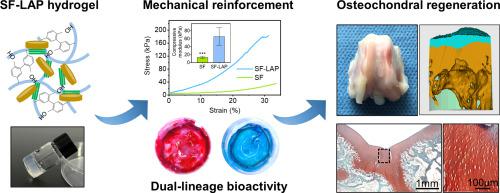Biomaterials Advances ( IF 5.5 ) Pub Date : 2021-05-29 , DOI: 10.1016/j.msec.2021.112215 Wei Zhang 1 , Yanan Zhang 2 , Aini Zhang 2 , Chen Ling 3 , Renwang Sheng 2 , Xiaolong Li 2 , Qingqiang Yao 4 , Jialin Chen 1

|
Osteochondral defects are characterized by damage to both articular cartilage and subchondral bone. Various tissue engineering strategies have been developed for osteochondral defect repair. However, strong mechanical properties and dual-lineage (osteogenesis and chondrogenesis) bioactivity still pose challenges for current biomaterial design. Silicate nanoclay has been reported to improve the mechanical properties and biofunctionality of polymer systems, but its effect on in vitro dual-lineage differentiation or in vivo osteochondral regeneration has not been extensively investigated before. Here, a novel enzymatically crosslinked silk fibroin (SF)-Laponite (LAP) nanocomposite hydrogel was fabricated and evaluated for osteochondral regeneration. The incorporation of a small amount of LAP (1% w/v) accelerated the gelation process of SF and greatly enhanced the mechanical properties and hydrophilicity of the hydrogel. In vitro investigations showed that the developed SF-LAP hydrogel was biocompatible and was able to induce osteogenic and chondrogenic differentiation of bone marrow-derived mesenchymal stem cells (BMSCs), validated by Alizarin red/Alcian blue staining, qPCR, and immunofluorescent staining. During an 8-week implantation into rabbit full-thickness osteochondral defects, the SF-LAP hydrogel promoted the simultaneous and enhanced regeneration of cartilage and subchondral bone. The repaired tissue in the chondral region was constituted mainly of hyaline cartilage with typical chondrocyte morphology and cartilaginous extracellular matrix (ECM). These findings suggested that the SF-LAP nanocomposite hydrogel developed in this study served as a promising biomaterial for osteochondral regeneration due to its mechanical reinforcement and dual-lineage bioactivity.
中文翻译:

具有双谱系生物活性的酶促交联丝-纳米硅酸盐增强水凝胶用于骨软骨组织工程
骨软骨缺损的特征是关节软骨和软骨下骨均受损。已经开发了用于骨软骨缺损修复的各种组织工程策略。然而,强大的机械性能和双谱系(成骨和软骨形成)生物活性仍然对当前的生物材料设计构成挑战。据报道,硅酸盐纳米粘土可改善聚合物系统的机械性能和生物功能性,但其对体外双谱系分化或体内的影响骨软骨再生以前没有得到广泛研究。在这里,一种新型的酶促交联丝素蛋白 (SF)-锂皂石 (LAP) 纳米复合水凝胶被制造并评估用于骨软骨再生。少量LAP(1% w/v)的加入加速了SF的凝胶化过程,大大增强了水凝胶的机械性能和亲水性。体外研究表明,开发的 SF-LAP 水凝胶具有生物相容性,能够诱导骨髓间充质干细胞 (BMSCs) 的成骨和软骨分化,经茜素红/阿尔新蓝染色、qPCR 和免疫荧光染色验证。在植入兔全层骨软骨缺损 8 周期间,SF-LAP 水凝胶促进了软骨和软骨下骨的同步和增强再生。软骨区域的修复组织主要由具有典型软骨细胞形态的透明软骨和软骨细胞外基质(ECM)组成。这些发现表明,本研究中开发的 SF-LAP 纳米复合水凝胶由于其机械增强和双谱系生物活性,可作为一种有前途的骨软骨再生生物材料。











































 京公网安备 11010802027423号
京公网安备 11010802027423号